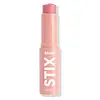What's inside
What's inside
 Key Ingredients
Key Ingredients

 Benefits
Benefits

 Concerns
Concerns

 Ingredients Side-by-side
Ingredients Side-by-side

Pentaerythrityl Tetraisostearate
EmollientCaprylyl Methicone
Skin ConditioningPhenyl Trimethicone
Skin ConditioningParaffin
PerfumingHydrated Silica
AbrasiveCeresin
Emulsion StabilisingCopernicia Cerifera Wax
Vp/Hexadecene Copolymer
Synthetic Beeswax
Emulsion StabilisingHydrogenated Soybean Oil
EmollientCaprylic/Capric Triglyceride
MaskingLauryl Laurate
Skin ConditioningCetyl PEG/PPG-10/1 Dimethicone
EmulsifyingStearic Acid
CleansingPhenoxyethanol
PreservativeCaprylyl Glycol
EmollientMicrocrystalline Wax
Emulsion StabilisingDiethylhexyl Syringylidenemalonate
Skin ProtectingTocopherol
AntioxidantPotassium Sorbate
PreservativeWater
Skin ConditioningHexylene Glycol
EmulsifyingAlumina
AbrasiveDimethicone
EmollientTriethoxycaprylylsilane
CI 42090
Cosmetic ColorantIron Oxides
CI 77742
Cosmetic ColorantMica
Cosmetic ColorantCI 15850
Cosmetic ColorantCI 45410
Cosmetic ColorantCI 16035
Cosmetic ColorantCI 77891
Cosmetic ColorantCI 19140
Cosmetic ColorantCI 15985
Cosmetic ColorantCI 47005
Cosmetic ColorantPentaerythrityl Tetraisostearate, Caprylyl Methicone, Phenyl Trimethicone, Paraffin, Hydrated Silica, Ceresin, Copernicia Cerifera Wax, Vp/Hexadecene Copolymer, Synthetic Beeswax, Hydrogenated Soybean Oil, Caprylic/Capric Triglyceride, Lauryl Laurate, Cetyl PEG/PPG-10/1 Dimethicone, Stearic Acid, Phenoxyethanol, Caprylyl Glycol, Microcrystalline Wax, Diethylhexyl Syringylidenemalonate, Tocopherol, Potassium Sorbate, Water, Hexylene Glycol, Alumina, Dimethicone, Triethoxycaprylylsilane, CI 42090, Iron Oxides, CI 77742, Mica, CI 15850, CI 45410, CI 16035, CI 77891, CI 19140, CI 15985, CI 47005
Isododecane
EmollientHydrogenated Polyisobutene
EmollientEthylene/Propylene Copolymer
AbrasiveMica
Cosmetic ColorantEthylene/Propylene/Styrene Copolymer
Squalane
EmollientHyaluronic Acid
HumectantCoconut Alkanes
EmollientButylene/Ethylene/Styrene Copolymer
Hydrogenated Lecithin
EmulsifyingPentaerythrityl Tetra-Di-T-Butyl Hydroxyhydrocinnamate
AntioxidantCoco-Caprylate/Caprate
EmollientTitanium Dioxide
Cosmetic ColorantCI 77491
Cosmetic ColorantCI 77492
Cosmetic ColorantCI 77499
Cosmetic ColorantCI 15850
Cosmetic ColorantCI 77510
Cosmetic ColorantCI 73360
Cosmetic ColorantCI 77163
Cosmetic ColorantCI 19140
Cosmetic ColorantIsododecane, Hydrogenated Polyisobutene, Ethylene/Propylene Copolymer, Mica, Ethylene/Propylene/Styrene Copolymer, Squalane, Hyaluronic Acid, Coconut Alkanes, Butylene/Ethylene/Styrene Copolymer, Hydrogenated Lecithin, Pentaerythrityl Tetra-Di-T-Butyl Hydroxyhydrocinnamate, Coco-Caprylate/Caprate, Titanium Dioxide, CI 77491, CI 77492, CI 77499, CI 15850, CI 77510, CI 73360, CI 77163, CI 19140
Ingredients Explained
These ingredients are found in both products.
Ingredients higher up in an ingredient list are typically present in a larger amount.
Ci 15850 is the pigment color red. It is an azo dye and created synthetically.
Azo dyes need to be thoroughly purified before use. This allows them to be more stable and longer-lasting.
This ingredient is common in foundations, lipsticks, and blushes. This color is described as brown/orangey red.
It has many secondary names such as Red 6 and Red 7. According to a manufacturer, Red 6 usually contains aluminum.
Learn more about CI 15850CI 19140 is also known as Tartrazine. Tartrazine is a synthetic dye used in cosmetics, foods, and medicine to add a yellow color.
Tartrazine is created from petroleum and is water-soluble.
Some people may experience allergies from this dye, especially asthmatics and those with an aspirin intolerance.
Learn more about CI 19140Mica is a naturally occurring mineral used to add shimmer and color in cosmetics. It can also help improve the texture of a product or give it an opaque, white/silver color.
Serecite is the name for very fine but ragged grains of mica.
This ingredient is often coated with metal oxides like titanium dioxide. Trace amounts of heavy metals may be found in mica, but these metals are not harmful in our personal products.
Mica has been used since prehistoric times throughout the world. Ancient Egyptian, Indian, Greek, Roman, Aztec, and Chinese civilizations have used mica.
Learn more about Mica